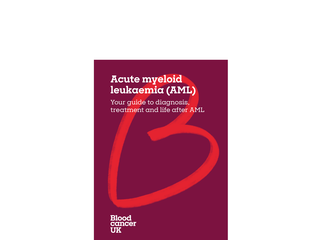What is acute myeloid leukaemia (AML)
Acute myeloid leukaemia is a type of blood cancer. It’s called ‘acute’ because it develops very quickly and often needs urgent treatment.
Normally, your body creates millions of new blood cells every second. AML happens when something goes wrong with this process.
What is AML?
In AML, certain types of blood cells don’t grow properly. This stops your blood doing the things it normally does to keep you healthy, like fighting off infections or carrying oxygen around the body.
These faulty blood cells (leukaemia cells) can quickly build up in your body. The more these leukaemia cells build up, the less room there is for normal blood cells to grow. This causes the symptoms of AML.
Fast treatment is often needed to reduce the number of leukaemia cells.

Get a weekly support email from us
We'll send you clear and simple information, practical tips, and advice from other people with blood cancer, to help during the first few weeks and months after diagnosis.
Who gets AML?
Over 2,900 people are diagnosed with AML each year in the UK. Three quarters of these (75%) are aged 60 or over, but AML can happen at any age. We have more information about causes of AML.
These web pages are about AML in adults. We have separate information about AML in children.
"In hospital, everyone around me was a lot older. I felt so different and like I didn't fit in."
Bav was diagnosed with AML as a teenager.
Read Bav's story about having blood cancer as a young person.

Types of AML
There are different subtypes of AML, depending on which genetic changes (mutations) the AML cells have, which types of blood cells are affected, and whether your AML has been caused by previous cancer treatment or developed from a previous blood condition. We explain this more in our information about prognosis and risk groups.
AML almost always affects white blood cells, which are part of your immune system. In very rare cases, it's the red blood cells or platelets that are faulty. These are very rare types of AML called acute erythroid leukaemia and acute megakaryoblastic leukaemia. The treatments for these types of AML are the same and the information on our website relates to all types of AML.
A small number of people with AML have a subtype called APL (acute promyelocytic leukaemia). This has quite different treatments. We have separate information about acute promyelocytic leukaemia (APL).
What's the prognosis for AML?
Prognosis means what could happen in the future. Everyone’s prognosis is personal to them and depends on things like your general health and the type of AML you have.
People have very different experiences, and nobody can ever know what will happen to an individual person. We have more information about prognosis for AML.
Thanks to research, treatments for AML are improving all the time.

Order your free guide to AML
If you've been told you have AML, this booklet covers treatments, questions to ask your medical team, and real stories of people living with AML.
